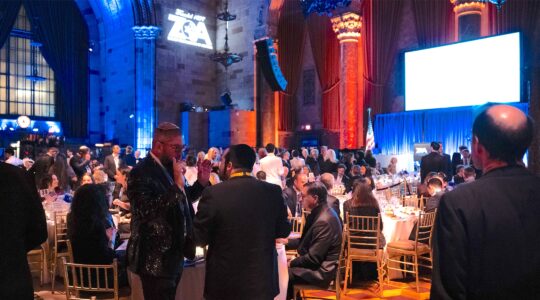The George Clooney movie that premieres Friday, “The Monuments Men,” tells the story of the 350-member team of professors, art historians and museum curators who scoured Europe for the millions of dollars worth of art looted by the Nazis. But there is a backstory worth talking about — the furor over the creation of the team in June 1943 touched off from those concerned about the fate of European Jews.
New York City Mayor Fiorello La Guardia put it this way in congressional testimony Nov. 24, 1943: “This very important problem [of rescuing Jewish refugees] … is not like the destruction of buildings or monuments, as terrible as that may be, because, after all, they may be rebuilt or even reproduced; but when a life is snuffed out, it is gone; it is gone forever.”
Rafael Medoff, director of the David S. Wyman Institute for Holocaust Studies in Washington, D.C., pointed out that the Roosevelt administration’s creation of the Monuments Men caught many by surprise. He noted that throughout the spring of 1943, “Jewish groups were urging creation of a government commission to rescue Jews, and the Roosevelt administration kept saying it couldn’t divert any resources to help refugees. Then suddenly in June, the president turned around and created a special commission to rescue historic monuments and paintings. Jewish groups weren’t against saving the paintings — they were just puzzled by the administration’s priorities.”
A group of activists formed the Bergson Group that took out ads in The New York Times questioning the Roosevelt administration’s priorities. It called “commendable” the effort to save European treasures of art, saying it “shows the deep concern of the United Nations governments toward the problems of culture and civilization. But should it not at least show equal concern for an old and ancient people who gave to the world the fundamentals of its Christian civilizations. … A government agency with the task of dealing with the problems of saving the Jewish people of Europe is the least the United Nations can do.”
“What less could be done for a whole people in agony and torture than to appoint a few men, with compassion in their hearts and knowledge and experience, for the task of saving countless human lives,” it added.
The Bergson Group also organized a group of 400 primarily Orthodox rabbis who marched to the White House on Oct. 6, 1943, to ask that American and Allied forces stop the destruction of European Jewry. Vice President Henry Wallace met them, but President Franklin D. Roosevelt ducked out a back door for another event, reportedly on the advice of several prominent American Jews and Jewish advisers who feared a meeting would generate anti-Semitism.
But the rabbis march and the perceived snub by Roosevelt received wide publicity and, Medoff said, “pressure from the congressional hearings, the newspaper ads, the rabbis’ march, behind the scenes lobbying by the Treasury Department, and other protests eventually compelled the Roosevelt administration to belatedly take some steps to aid Jews fleeing from the Holocaust.”
It did that on Jan. 22, 1944, with the creation of the War Refugee Board, tasked with the “immediate rescue and relief of the Jews of Europe and other victims of enemy persecution.”
After the war, its first director, John Pehle, described the board as “little and late.” It was, however, credited with saving as many as 200,000 Jews. Medoff noted that Roosevelt created the board just days before the Senate was to vote on a resolution calling for the establishment of such a body.
The Smithsonian Institution’s Archives of American Art is opening an exhibit Friday that displays the archival documents that created the Monuments Men, officially designated by Roosevelt as the Monuments, Fine Arts and Archives section. But it deals with art rescue only and not the controversy it sparked.
A spokesman for the museum, Linda St. Thomas, said the museum is “well aware” of the historical context in which Roosevelt created the Monuments Men. But she said the exhibit will be in a “small gallery” that will contain “just documents that relate to the creation of this rescue effort.”
“Its focus is very narrow,” she said. “It’s not a history exhibit.”
Support the New York Jewish Week
Our nonprofit newsroom depends on readers like you. Make a donation now to support independent Jewish journalism in New York.
Reflecting on the rescue efforts that occurred during World War II, Medoff said: “Consider this irony: the Roosevelt administration agreed to divert military resources and personnel to rescue paintings by [Marc] Chagall — but when Chagall himself had tried to get a visa to go from Vichy France to the United States a few years earlier, the U.S. stalled on his request and he almost didn’t get out. In fact, Varian Fry, who organized Chagall’s rescue, was forced to cut short his life-saving mission in France because the Roosevelt administration canceled his passport after the Nazis and Vichy France complained about Fry’s activities. If the administration had shown as much interest in saving refugees like Chagall as it showed in saving Chagall’s paintings, many more innocent Jews could have been rescued.”
The New York Jewish Week brings you the stories behind the headlines, keeping you connected to Jewish life in New York. Help sustain the reporting you trust by donating today.




